

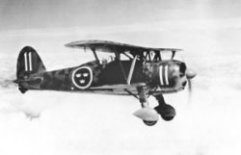
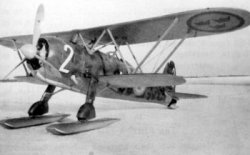
During the early part of 1940, the Finnish-Soviet Winter War raged. The Swedish volunteer unit F 19 (F=Flottilj, approx. Wing) served on the Finnish side and defended the north part of Finland with some success against the Soviet bombing raids. However to be really effective the unit needed better fighters than the Gloster Gladiator it had on strength. In early February 1940, a nation-wide collection of funds for new fighters for F 19 were started in Sweden. This nation-wide collection of help to Finland had started by a sermon made by vicar Isaac Been, who declared “What Finland really needs are fighters! And the devil shall be expulsed by fighters!”. On 15 February, a first contract for five Fiat CR.42s was signed, followed by a second for seven more on 24 February. The type was selected due to its immediately availability and the ease with which skies could be fitted. The intention was that the CR.42s were to enter service with F 19 in early April 1940. However, with the ending of the Winter War on 13 March, Finland declined delivery of the CR.42s, preferring to receive the equivalent cash instead. The Swedish Air Force quickly decided to take over the 12 aircraft, for use as reconnaissance aircraft with F 3 at Linköping.
Meanwhile, the US decided to stop the delivery of 264 ordered fighters to Sweden. The fighters were the Seversky-Republic EP-1-106 (Swedish designation: J 9) (J=Jaktplan, which means fighter) and the Vultee Vanguard (Swedish designation: J 10). These fighters was to be delivered to F 8, F 9, F 10 (F=Flottilj, approx. Wing), but only 60 was delivered. The problem was now what to do, because new (and hopefully modern) equipment was urgently needed. The Swedish Air Force thus decided to order an additional 60 CR 42s from Italy. Totally 72 CR 42s was ordered and was the third and largest export order for the type. The Italian aircraft got the Swedish designation J 11. Sweden also bought four destroyers and 60 Reggiane Re.2000 Falco I (J 20) from Italy.
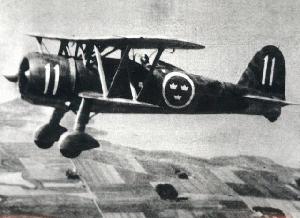
The J 11s were delivered between April 1940 and September 1941, bearing the serials 2501-2572. They were powered by Fiat A74R.1C.38 engines providing a maximum 870 hp. The first dozen machines were flown to Sweden, the initial five leaving Italy on 29 February 1940, and the remaining seven on 15 March. The twelve first planes to arrive in Sweden was used as reconnaissance planes at F3 during the first summer were they were popular substitutes for the old Fokkers. The remainder were crated and delivered to CVM (Centrala Flygverkstäderna Malmslätt) for assembly, these arriving in Sweden five at a time from 20 December 1940 until 11 June 1941, and then in somewhat desultory fashion until the final three were despatched from Italy on 3 September 1941.
By November 1941 all the Falcos were in service and they bore the designation of J 11 and were assigned to F 9 (F=Flottilj approx. Wing) at Säve, Gothenburg. Modifications included 20-mm armour plate behind the pilot, radio equipment and skis for winter service.
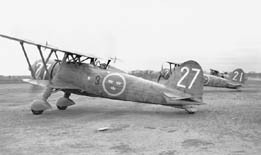
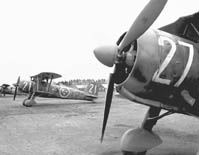
By early 1942, two J 11s from F 9were on permanent stand-by and one full squadron of the Wing was on 24-hour stand-by. From mid-march to late April 1942, the 1st Squadron was based in Kiruna in northern Sweden, to defend the ore-carrying railway to Norway. At this time the aircraft were fitted with skies. 2nd and 3rd Squadrons remained at Säve and performed a few interceptions over Swedish territory and escorted these out of Swedish airspace. Mostly however, the J 11s were too slow to intercept the intruders but despite this, the type was well liked by the pilot. However, poor standards on the material and hard use resulted in many accidents and this meant that they quickly needed to be replaced. In October 1943, F 9 started to replace the J 11 with the indigenous J 22 and some of the J 11 were transferred to the newly formed F 13 and became this unit’s first type. Remaining CR 42 was declared obsolete on 14 March 1945 and the 13 remaining aircraft (with six additional as spares) were purchased by AB Svensk Flygtjänst.
Civil use of the Fiat CR.42 Falco in Sweden
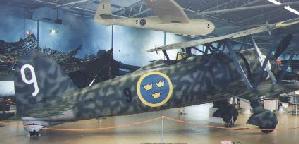
Fiat CR.42 Falco
Type:__________Fighter and Reconnaissance
Span:__________9.7 m
Length:________8.25 m
Engine:________Fiat A74R 1C 38 / 840 hsp
Max speed:_____405 km/h
Max ceiling:___10000 m
Armament:______2x12.7 mm machine guns
Number in AF:__72
In service:____1940-1945
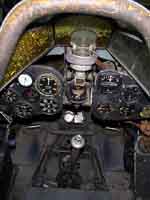
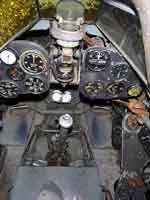
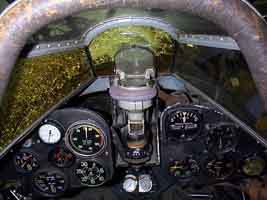

Sources:
En flykt genom tiderna - Staten Försvarshistoriska Museer
Att flyga är att leva
J11 Fiat CR 42 - Mikael Forslund, 2001 Mikael Forslund Produktion, Falun, ISBN 91-631-1669-3
The Fiat CR.42 - Gianni Cattaneo, 1971
